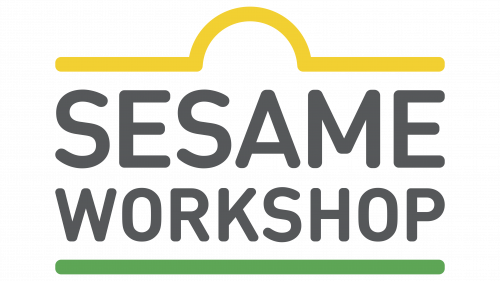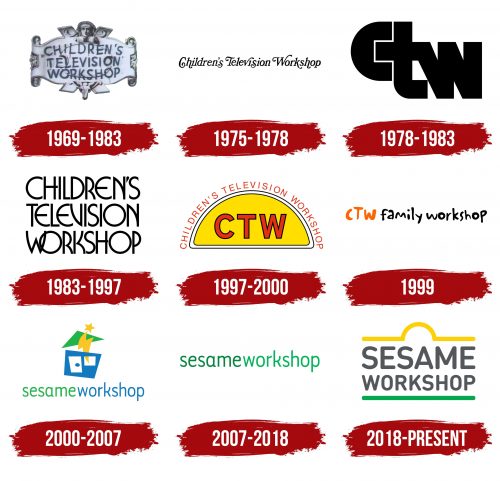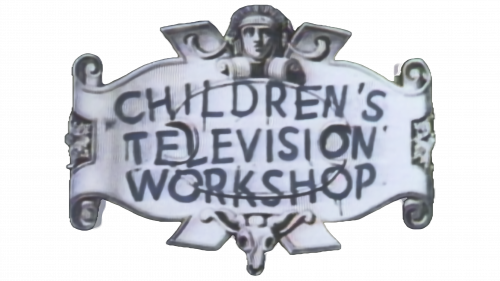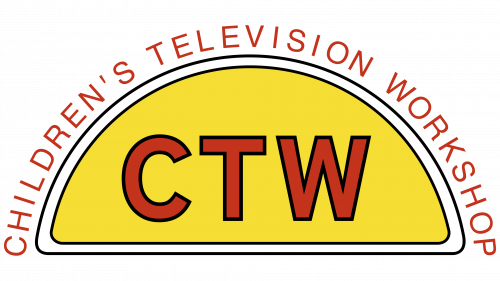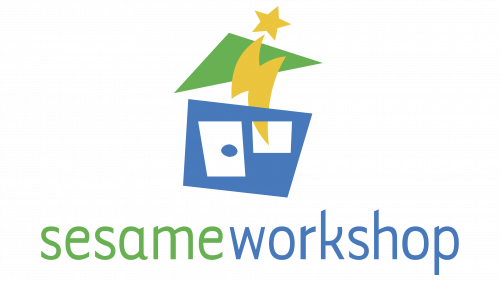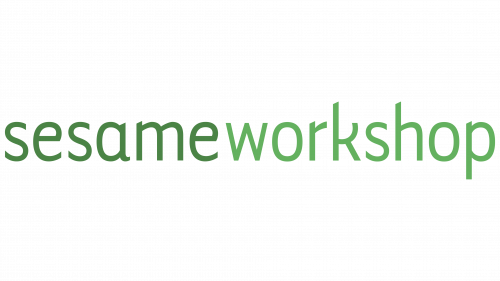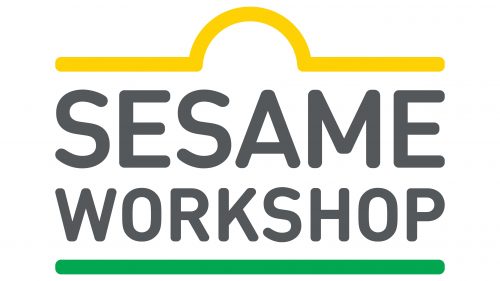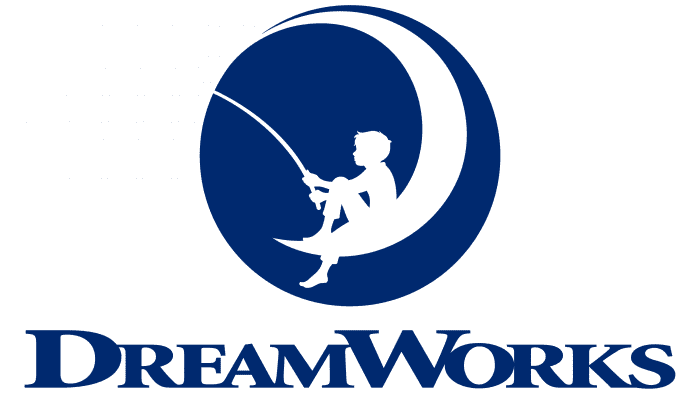The Sesame Workshop logo symbolizes the path to the immeasurable treasures of knowledge that viewers discover through the company’s programs. The emblem reflects the brand’s main goal — to support children’s development and learning by providing unique content that helps kids grow, learn new things, and acquire valuable skills. The idea behind the logo is to show that Sesame Workshop entertains and paves the way for learning and development, inspiring children to discover new worlds full of opportunities and knowledge.
SW: Brand overview
Sesame Workshop began in 1968 when psychologist Lloyd Morrisett and television producer Joan Ganz Cooney co-founded the non-profit Children’s Television Workshop (CTW). They aimed to create an educational TV series for preschool children, particularly those from low-income families.
The idea originated when Morrisett noticed his young daughter’s fascination with television. He wondered if this medium could be used for educational purposes. With Cooney’s background in television production, they began developing the concept for a groundbreaking program.
In 1969, Sesame Street, the organization’s first and most famous creation, premiered. Combining Jim Henson’s puppetry with educational content and entertainment, the show was revolutionary. Sesame Street quickly became popular and recognized as a valuable tool for early childhood education.
The organization expanded during the 1970s. It launched Sesame Street Magazine, offering additional educational resources for children and parents. The team also started producing toys and other educational products based on Sesame Street characters.
In the 1980s, the growth continued with the production of new shows. In 1983, they launched 3-2-1 Contact, a science program for older children, marking a broader educational reach.
By the 1990s, international expansions became a priority. Sesame Street was adapted for different countries, with localized characters and educational content reflecting specific regions’ cultural and educational needs.
In 2000, the organization was renamed Sesame Workshop, reflecting its expanded mission beyond television. The new name underscored a commitment to using various media platforms to achieve educational goals.
Throughout the 2000s, the organization embraced digital technology. The team developed mobile apps, interactive websites, and online games to complement its TV programming and engage with children in new ways.
In 2015, the group partnered with HBO, which provided additional funding for more episodes of Sesame Street and helped support the development of new projects. The following year, the company launched Sesame Studios, a digital production arm focused on creating original content for YouTube and other online platforms. This move recognized how children’s media consumption habits were evolving.
In 2018, they introduced Sesame Street in Communities, expanding their social impact efforts by providing resources and support to help children and families navigate life’s challenges.
2019 marked Sesame Street’s 50th anniversary, with special episodes and events highlighting the show’s long-lasting influence on education and culture. Despite global challenges in 2020, the organization adapted by creating new content that addressed the stress and uncertainty children and families face and providing resources to help manage anxiety during difficult times.
In 2021, HBO Max debuted The Not-Too-Late Show with Elmo, demonstrating the group’s continued commitment to innovation and engaging with children through new media formats. International expansion continued in 2022, with new editions of Sesame Street and broader educational outreach in various countries.
By 2023, the company had grown into a leading educational institution, blending early childhood development, media, and technology. It continues to create innovative educational programs that evolve with the changing needs of children and families worldwide.
Over the past 50 years, the organization has transformed from the creator of a single television show into a global educational force, shaping the lives of millions of children. Its success comes from blending entertainment with education, constantly adapting to the evolving media environment while focusing on children’s growth and well-being.
Meaning and History
What is SW?
This nonprofit organization, known for creating “Sesame Street,” is a pioneer in children’s education and entertainment. It revolutionized the concept of preschool learning by using television to engage children and teach them important skills. The organization covers various topics, from basic literacy and math to social issues such as diversity and inclusion. Through vibrant characters like the Muppets and educational stories based on a curriculum, the organization continues to impact the educational field. In addition to the TV show, it produces books and digital media and adapts its programs for various cultural audiences, influencing children’s development worldwide.
1969 – 1983
The organization’s original name — Children’s Television Workshop — was presented on a scroll, styled like ancient maps from adventure films. This design emphasized the organization’s important mission — preparing children for school through television. With its captivating visual style, the emblem aimed to make the learning process both beneficial and exciting. At the top and bottom of the scroll were heads symbolizing the figurehead of a ship, ready to embark on discoveries and unexplored shores. The lettering was handwritten, enhancing the association with education and school activities and underscoring the organization’s primary goal — learning through television.
1975 – 1978
After successfully launching two popular children’s shows, the company expanded its repertoire by including programs for an adult audience. This move led to a redesign of the logo. The name was written in an elaborate black font reminiscent of Disney’s style. The logo had a magical and fairy-tale-like appearance, reflecting the variety of produced content. This design successfully combined elements suitable for children’s educational programs and more mature, intellectual shows while maintaining a connection to the brand’s educational mission.
1978 – 1983
The emblem created in the late 70s has an impressive and serious appearance. Three massive black letters, CTW, are tightly intertwined, like puzzle pieces, forming a cohesive composition. This design approach symbolizes the structured and reliable educational programs the company offers preschools. The logo emphasizes the idea of an organic combination of different forms of learning, including cartoons, lessons, and books. The concept reflects the brand’s essence — a comprehensive approach to education through entertaining programs, represented by the puzzle idea, where each element complements the other, creating a unified system.
1983 – 1997
The company focused its efforts on creating children’s content, including the production of science-oriented series. The emblem from this period comprises thin and flexible letters arranged in three levels, giving the logo a neat rectangular shape with straight edges. The font harmoniously combines rounded and straight lines, creating an impression of lightness and playfulness while conveying professionalism. This approach emphasizes the company’s mission — to create educational and entertaining programs where knowledge is presented in an accessible and engaging way, making it easy for children to absorb.
1997 – 2000
In the new logo, the image of the rising sun symbolizes hope for a bright future, reflecting the optimism accompanying the company’s reorganization and the influx of private investments. The half-circle, painted in yellow, conveys a sense of warmth and emerging energy. Against this bright background, the company’s acronym stands out in red letters with a black outline, giving the emblem clarity and expressiveness. The full brand name is in thin red font along the circle’s edge instead of sun rays. Overall, the logo conveys a joyful mood and lightness, evoking associations with childhood and fun, while its geometric shapes add a sense of order and harmony.
1999
The company launched a new channel called Noggin to broadcast its programs while updating its website. The channel’s logo resembles cartoon credits, emphasizing its connection to on-screen viewing. The letters in the name are designed in an unconventional style: they vary in thickness, height, and angle, giving the logo a playful and childlike sense of ease. The red acronym flows seamlessly into the new website name — “Family Workshop,” specifically created for families with young children. The site’s content is aimed at preschoolers and their parents, offering them educational and developmental programs easily and engagingly.
2000 – 2007
The company’s logo was updated after a change in leadership and rebranding, presenting a bright and symbolic design. The image resembled a child’s building block: a blue house with a green roof that appeared to soar upward like a star floating in the sky. This element reflected the brand’s main goal—to support children in their aspirations, give them a great start in life, and help them succeed, turning them into “stars.”
The new name, Sesame Workshop, was now written as one word and styled with thin, elegant letters. The name refers to the famous phrase from the tale of Ali Baba and the Forty Thieves: “Open, Sesame,” which unlocked a path to vast treasures. In the brand context, this phrase symbolizes the “treasures of knowledge,” highlighting its educational mission. The logo also referenced their iconic show, Sesame Street, which played a key role in the company’s educational programs.
Colors were used to visually separate the words. The green color of “Sesame” was associated with a seed, symbolizing life potential, growth, and wisdom. The blue word “Workshop” emphasizes the creation and learning process, drawing attention to the ongoing work of unlocking children’s potential.
2007 – 2018
The brand’s emblem was simplified to a concise name written in lowercase letters using two shades of green. This choice emphasizes the focus on the company’s educational mission. The calligraphic style of the characters hints at elegance and attentiveness in the approach to learning. The green tones in the logo reflect work with the younger generation, highlighting growth and development, as well as the brand’s contribution to the planet’s future.
One of the company’s significant steps was the creation of The Joan Ganz Cooney Center — a research center dedicated to studying and improving digital learning for children. This expanded the brand’s influence in the field of education, reinforcing its leadership and innovative approach to teaching. The emblem symbolizes educational goals, the pursuit of progress, and creating a better world for future generations.
2018 – today
The company name “Sesame Workshop” is placed between two lines, each carrying a symbolic meaning. The lower green stripe is a design element symbolizing earth, plants, and all things that grow and develop. This green line is perceived as the soil in which the “seeds” of knowledge, planted through the company’s educational projects, take root.
The upper line, yellow in color, is slightly curved in the center and resembles the rising sun. It symbolizes the light and warmth that help these “seeds” grow. The curve in the line is associated with when a sprout breaks through the ground, reaching for the light—toward knowledge and growth. This visually represents how the company, through its programs, helps children grow and learn.
The logo’s font is modern and simple yet with soft, rounded edges, making it accessible and friendly for viewers of all ages. There are no overly complex shapes—everything is clear, understandable, and easy to read. This aligns with the company’s goal of being approachable and accessible for children and parents.
The logo design echoes the classic emblem of their flagship project, “Sesame Street.” It has the same minimalism and clarity of lines. Like the show, this logo embodies a brand representing a whole concept: an educational platform where knowledge, like seeds, grows with careful nurturing.
When the company created this logo, its development was directly connected to the “Sesame Workshop” mission—helping children learn through play and fun. Green and yellow represent nature and life and harmoniously reflect the company’s work.
